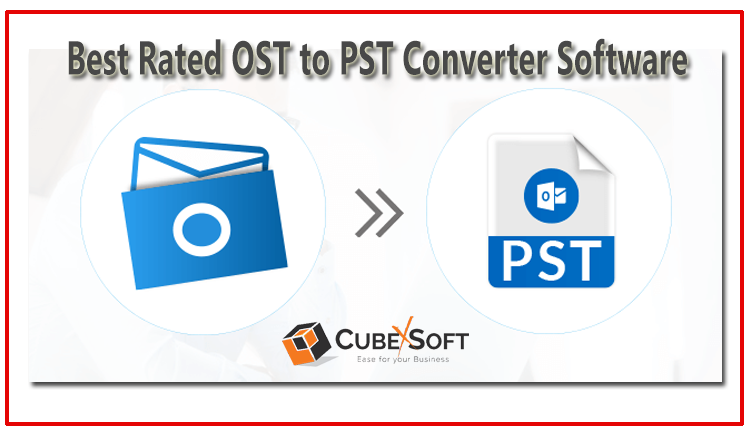How to Export Outlook Offline OST Files to Outlook PST?

This blog will provide you with a detailed explanation on how to import OST files into Microsoft Outlook. If you're facing issues accessing your old Outlook data or migrating to a new system, understanding OST files and how to work with them is crucial. You'll learn about:
- What OST files are and where they are located on your system
- When and why you might need to open OST files in Outlook
- Step-by-step instructions to migrate your Outlook OST data files into Outlook with CubexSoft OST Converter Tool.
What is an OST File?
An OST file stands for Offline Storage Table. It is a file format used by Microsoft Outlook to store a complete copy of your mailbox profile, including: emails, contacts, tasks, journals, etc. The OST file allows you to work offline, and any changes you make, such as sending emails, drafting messages, or updating contacts are automatically synchronized with the server once Outlook reconnects to the internet.
Location of Outlook OST File
The default location of the OST file depends on your Windows version and Outlook configuration. However, in most cases, it is stored here:
C:\Users\<YourUsername>\AppData\Local\Microsoft\Outlook
Note: The actual location may vary slightly depending on the Outlook version or Windows user profile settings, but it is always located within the AppData\Local directory.
How to Manually Locate OST Files in Outlook
You can find your OST file by following these simple steps:
- Open Microsoft Outlook.
- Click on the File tab in the top-left corner.
- Select Account Settings, then click Account Settings again from the dropdown.
- In the Account Settings window, go to the Data Files tab.
- Choose your Outlook data file (with a .ost extension).
- Click on Open File Location.
This will take you directly to the folder where your OST file is stored.
Understanding the OST file and its location is important, especially when troubleshooting Outlook issues, migrating data, or converting files. Let me know if you want guidance on converting OST to PST or recovering data from a corrupted OST file.
What Leads to Import OST Files to Outlook?
OST (Offline Storage Table) files are automatically created by Outlook to store your mailbox data locally, allowing you to access and work with your emails even without an internet connection. However, there are several scenarios where you might need to convert OST to PST and import it into Outlook. Here's why:
Key Reasons to Import OST Files into Outlook (Convert OST to PST):
- To Share Mailbox Data with Another User: OST files are linked to a specific Outlook profile and cannot be shared directly. If you want to transfer mailbox contents to another user, you must convert the OST to a PST file, which is portable and transferable.
- For Enhanced Privacy and Security: PST files offer password protection, unlike OST files. So, if you’re dealing with sensitive or confidential information, using a PST format adds an extra layer of security.
- To Prevent Data Loss Due to Corruption: OST files can become orphaned or corrupted due to server issues or account deletion. Converting OST to PST ensures you have a safe backup of your data in a format that’s easier to manage and recover.
- To Manage Large Mailboxes Efficiently: You can’t split or merge OST files, but PST files can be split into smaller parts, making them more manageable and improving Outlook’s performance.
How to Import OST File in Outlook 2016, 2019, and Other Versions
Microsoft Outlook does not support directly importing OST files into Outlook 2016, 2019, or other versions. OST files are tied to a specific Outlook profile and Exchange/IMAP account, so they can’t be opened directly once disconnected or orphaned.
To access or migrate OST data, you first need to convert the OST file into PST format, which Outlook does allow for import.
Below, we’ll walk you through two manual methods to convert OST to PST. Once the OST file is converted, importing it into Outlook becomes easy and straightforward.
Method 1: Use AutoArchive to Export OST Data to PST
Outlook includes an AutoArchive feature that can automatically save your mailbox data to a PST file at scheduled intervals.
Steps to Use AutoArchive:
- Open Microsoft Outlook on your system.
- Click the File tab, then select Options from the left panel.
- In the Outlook Options window, go to the Advanced tab.
- Under AutoArchive, click on AutoArchive Settings.
- Now, configure your settings:
- Choose how often to run AutoArchive (e.g., every 7 days)
- Select the location to save the archived PST file
- Choose the folders to archive
Outlook will now regularly archive older mailbox data from the OST file into a PST file, which can be later imported into any version of Outlook.
Steps to Convert OST to PST via Import/Export:
- Launch Microsoft Outlook on your system with the active Outlook profile connected to the OST.
- Click on the File tab in the top menu.
- Select Open & Export, then choose Import/Export.
- In the Import and Export Wizard, choose: Export to a file and Click Next.
- Select Outlook Data File (.pst) and click Next.
- Choose the mailbox folder(s) you want to export (e.g., Inbox, Sent Items).
- You can include subfolders if needed.
Major Limitations of the Manual Approach to Convert OST to PST
You can’t convert the entire mailbox in a single go. You’ll need to repeat the steps multiple times to export different folders, which is inefficient.
These procedures are better suited for Outlook experts. A non-technical or first-time user may find them confusing or make mistakes during the process.
Manual methods require an active Outlook profile connected to the OST file. If the original account is deleted or inaccessible, the OST file becomes orphaned and cannot be imported.
If your OST file is damaged, Outlook will not recognize or open it, and you’ll need to repair it first before even attempting conversion.
The process becomes lengthy and complex, especially if the OST file is large or you're migrating multiple profiles.
Use a Professional Tool to Import OST Files to Outlook
When manual methods fall short due to file corruption, orphaned OST files, or the need for advanced conversion, a professional OST to PST converter tool becomes essential. One such trusted solution is the CubexSoft OST to PST Converter Tool, widely recognized for its reliability, speed, and versatility. This robust tool is designed to simplify OST file conversion and migration with a range of smart features:
· Add and convert multiple OST files at once, saving time during large-scale migrations
· Provides a detailed, folder-wise preview of all mailbox items (emails, contacts, calendars, etc.)
· Allows selective conversion, giving you more control over what gets exported
· Convert OST files not just to PST, but also to: PDF, MBOX, EML, MSG, DOC, Zimbra, HTML, and more. This flexibility makes the tool highly versatile for cross-platform usage.
· Step-by-step layout guides you through the entire conversion process smoothly
Final Words!
In this blog, we discussed the importance of locating OST files on your system and explored manual methods to help you access or convert them. Each method is easy to follow and can be chosen based on your technical comfort and the situation.
However, if you're planning to shift from OST to PST, especially in cases of corruption, inaccessibility, or orphaned files, we strongly recommend using a professional OST to PST Converter tool.
- Art
- Causes
- Best Offers
- Crafts
- Dance
- Drinks
- Film
- Fitness
- Food
- Jogos
- Festival
- Gardening
- Health
- Início
- Literature
- Music
- Networking
- Outro
- Party
- Religion
- Shopping
- Sports
- Theater
- Wellness



